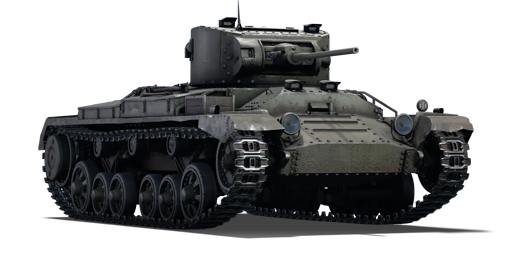



The Valentine Mk I was a British infantry tank. Its development started as a private venture by Vickers-Armstrong in 1938, based on experience with the A9, A10 and A11 cruiser and infantry tank designs. The War Office initially wasn’t satisfied with only a two-man turret, in which the tank commander was also acting as a loader, decreasing the crew's effectiveness in battle. However, with the situation in Europe worsening, the design was approved in April 1939 and first deliveries were made in May 1940. The Valentine I had a riveted hull, was powered by a 135 hp AEC A189 petrol engine and used an OQF 2-pounder Mk IX gun and coaxial 7.92 mm BESA machine gun. As the Valentine was an infantry tank, its maximum speed was only 24 km/h forward and 3 km/h in reverse.
The Valentine Mk I was introduced along with the initial British tree line in Update 1.55 "Royal Armour". Featuring a quite potent 40 mm gun paired with fast reload and excellent all-round armour protection, it is a formidable opponent. When angled, most of its opponents will struggle to penetrate its hull armour. The turret, although more vulnerable, can also deflect a few rounds due to its shape. The main drawback of the Valentine is its very slow speed, only 3 km/h in reverse and a low maximum speed of only 24 km/h, making the Valentine slower than most of its contemporaries. It also has a low crew count of only three, and weak optics magnifying ranging between 1.9–3.5x zoom, making longer-range shots quite challenging.
| Ammunition | Type | Armor penetration (mm) at a distance: | |||||
|---|---|---|---|---|---|---|---|
| 10 m | 100 m | 500 m | 1000 m | 1500 m | 2000 m | ||
| AP | 72 | 68 | 52 | 37 | 27 | 19 | |
| APCBC | 89 | 86 | 77 | 66 | 57 | 50 | |
| AP | 80 | 75 | 58 | 41 | 30 | 21 | |
| APHE | 66 | 62 | 49 | 36 | 26 | 19 | |
| Belt | Belt filling | Armor penetration (mm) at a distance: | |||||
|---|---|---|---|---|---|---|---|
| 10 m | 100 m | 500 m | 1000 m | 1500 m | 2000 m | ||
| AP-I/AP-I/AP-T | 9 | 8 | 6 | 3 | 0 | 0 | |












Mobility | |
|---|---|
Protection |
|---|
Firepower | ||
|---|---|---|